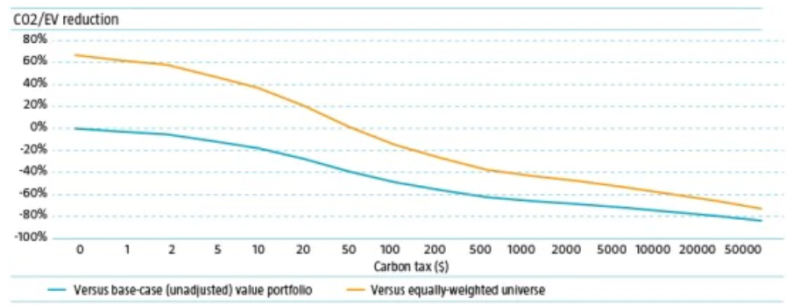Given the growing impetus to tackle climate change, it is seems inevitable that carbon emissions will be penalized more heavily in the future. While various emissions mitigating measures already exist, including fuel excise duties and emissions trading systems, the scope and effectiveness of these methods is currently limited. Thus, one can expect an increasing focus on carbon taxation as a mechanism to curb emissions.
From a corporate perspective, the cost implications of carbon taxes will likely become more punitive going forward. And in terms of investments, traditional valuation metrics – such as price-to-earnings (P/E) ratios – do not yet reflect the costs of carbon emissions. In anticipation of likely future developments, we examined the impact of incorporating a hypothetical carbon tax in valuation ratios.1
Our research is related to a recent stream of literature that modifies traditional valuation metrics by incorporating intangibles, such as knowledge capital, organizational capital and brand value.2 However, whereas these studies adjust valuations upwards by identifying unrecognized assets, factoring in carbon pricing results in downward adjustments in valuations to account for unrecognized liabilities.
“
Factoring in carbon pricing results in downward adjustments in valuations to account for unrecognized liabilities
Mathematical relationship between carbon taxes and carbon footprint constraints
Our research demonstrates that applying a carbon footprint reduction constraint to a value portfolio is mathematically the same as following a carbon-tax-adjusted value strategy. This means that a certain percentage of carbon footprint reduction corresponds to a specific level of carbon tax, and vice versa. This insight provides more clarity on the implicit assumptions behind decarbonizing investment portfolios, while it also gives us an economic interpretation to portfolio footprint reduction targets.
In our investigation, we analyzed a sample of developed market stocks for the period December 1985 to August 2021. We first compared a carbon-tax-adjusted value strategy and a value portfolio optimized with a carbon budget constraint, to illustrate the equivalence between the two approaches.
For the carbon-tax-adjusted value approach, we sorted stocks into five quintile portfolios based on their carbon-tax-adjusted earnings before interest, taxes, depreciation and amortization/enterprise value (EBITDA/EV) ratios. For solving the optimization problem with a carbon budget constraint, we used the SciPy linear programming functionality, where portfolio weights were restricted between 0 and 5/N, with N being the total number of available stocks.
Figure 1 displays the weighted average EBITDA/EV and CO2/EV levels of top quintile carbon-tax-adjusted value portfolios at different carbon tax levels, along with portfolios optimized with various carbon budgets (as a percentage of market carbon footprint), as at end August 2021. The dots, which represent optimal portfolios given a specific carbon tax and carbon constraint, lie on exactly the same curve. This illustrates that the maximum exposure to EBITDA/EV for a certain carbon footprint can be achieved by using either a tax or a portfolio constraint. This curve can be seen as the value-carbon efficient frontier.
Figure 1 | Simulated portfolio levels of EBITDA/EV for various carbon tax and carbon constraint levels

Source: Refinitiv, TruCost, Robeco Quantitative Research. Our sample consists of MSCI World constituent stocks at the end of every month from December 1985 to August 2021. Before 2001, we do not have access to MSCI World constituents, so we use FTSE developed as a proxy. We exclude financials, since the EBITDA/EV measure is not defined for such stocks. For the carbon emissions we take the combined scope 1 and 2 emissions. We also exclude a small number of stocks for which carbon emissions data is missing.
クオンツに関する最新の「インサイト」を読む
ロベコのニュースレターにご登録いただくことで、いち早く最新のインサイトを入手し、環境に優しいポートフォリオの構築にお役立てください。

Congratulations David Blitz for surpassing 100,000 downloads
We would like to congratulate David Blitz for surpassing the 100,000 downloads mark for his inspiring and thought-provoking research papers on SSRN.
Carbon tax sweet spot for carbon footprint reduction
We also examined the long-term characteristics of carbon-tax-adjusted value strategies. In one of our analyses, we evaluated how carbon taxes reduce the carbon footprint of a value portfolio. Figure 2 shows the percentage reduction in the carbon footprint of the top quintile portfolio, measured against the base case top quintile portfolio without a carbon tax, as well as the equally-weighted universe of all stocks.
We observed that the largest carbon tax effect occurred in the USD 10-100 range. For the top quintile portfolio, a carbon tax of USD 10 led to an 18% lower carbon footprint compared to the base case; a USD 50 tax resulted in a 39% lower carbon footprint; and a USD 100 tax amounted to a 49% lower carbon footprint. We also noted that carbon tax levels below USD 10 did not have a significant impact, while those above USD 100 had a progressively smaller effect on the portfolios.
Figure 2 | Simulated average carbon footprint (CO2/EV) reduction of carbon-tax-adjusted value (EBITDA/EV) top quintile portfolios versus base case value portfolio

Source: Refinitiv, TruCost, Robeco Quantitative Research. Our sample consists of MSCI World constituent stocks at the end of every month from December 1985 to August 2021. Before 2001, we do not have access to MSCI World constituents, so we use FTSE developed as a proxy. We exclude financials, since the EBITDA/EV measure is not defined for such stocks. For the carbon emissions we take the combined scope 1 and 2 emissions. We also exclude a small number of stocks for which carbon emissions data is missing.
In our research paper, we also scrutinized the impact of carbon taxes on the portfolios’ value exposure. We observed that the EBITDA/EV exposure of the top quintile portfolio was virtually unaffected by carbon taxes up to USD 50, and slowly began to decay after that. Even at a carbon tax level of USD 1,000, a large part of the base case EBITDA/EV exposure still remained.
The impact of carbon taxes on performance
Furthermore, we analyzed the impact of carbon taxes on returns. To do this, we sorted stocks into five quintile portfolios on their carbon-tax-adjusted EBITDA/EV ratios at the end of every month, and then computed the return of the five quintiles over the subsequent month. Figure 3 illustrates that the outperformance of the top quintile portfolio was effectively immune to carbon tax levels up to USD 100. At higher tax levels, the performance began to deteriorate, but it took a carbon tax of over USD 20,000 to fully wipe out the performance of the top quintile portfolio.
Figure 3 | Simulated cumulative outperformance of carbon-tax-adjusted value (EBITDA/EV) top quintile portfolios versus equally-weighted universe over time

Source: Refinitiv, TruCost, Robeco Quantitative Research. Our sample consists of MSCI World constituent stocks at the end of every month from December 1985 to August 2021. Before 2001, we do not have access to MSCI World constituents, so we use FTSE developed as a proxy. We exclude financials, since the EBITDA/EV measure is not defined for such stocks. For the carbon emissions we take the combined scope 1 and 2 emissions. We also exclude a small number of stocks for which carbon emissions data is missing.
Conclusion
Research empirically found that carbon taxes up to USD 100, corresponding with a portfolio carbon footprint reduction of about 50%, had little effect on the characteristics and the performance of the long side of an EBITDA/EV value strategy. However, to increase the carbon footprint reduction to 70%, the assumed carbon tax would need to rise from USD 100 to about USD 5,000. Such a level does not seem realistic, and it would also have an adverse effect on the performance of the value strategy.
Footnote
1 See: Blitz, D., and Hoogteijling, T., November 2021, “Carbon-tax-adjusted value”, working paper.
2 See: Park, H., October 2019, “An intangible-adjusted book-to-market ratio still predicts stock returns”, Critical Finance Review, forthcoming; Lev, B., and Srivastava, A., March 2020, “Explaining the recent failure of value investing”, working paper; and Arnott, R. D., Harvey, C. R., Kalesnik, V., and Linnainmaa, J. T., January 2021, “Reports of value’s death may be greatly exaggerated”, Financial Analysts Journal.
Download the publication / レポートのダウンロード
重要事項
当資料は情報提供を目的として、Robeco Institutional Asset Management B.V.が作成した英文資料、もしくはその英文資料をロベコ・ジャパン株式会社が翻訳したものです。資料中の個別の金融商品の売買の勧誘や推奨等を目的とするものではありません。記載された情報は十分信頼できるものであると考えておりますが、その正確性、完全性を保証するものではありません。意見や見通しはあくまで作成日における弊社の判断に基づくものであり、今後予告なしに変更されることがあります。運用状況、市場動向、意見等は、過去の一時点あるいは過去の一定期間についてのものであり、過去の実績は将来の運用成果を保証または示唆するものではありません。また、記載された投資方針・戦略等は全ての投資家の皆様に適合するとは限りません。当資料は法律、税務、会計面での助言の提供を意図するものではありません。 ご契約に際しては、必要に応じ専門家にご相談の上、最終的なご判断はお客様ご自身でなさるようお願い致します。 運用を行う資産の評価額は、組入有価証券等の価格、金融市場の相場や金利等の変動、及び組入有価証券の発行体の財務状況による信用力等の影響を受けて変動します。また、外貨建資産に投資する場合は為替変動の影響も受けます。運用によって生じた損益は、全て投資家の皆様に帰属します。したがって投資元本や一定の運用成果が保証されているものではなく、投資元本を上回る損失を被ることがあります。弊社が行う金融商品取引業に係る手数料または報酬は、締結される契約の種類や契約資産額により異なるため、当資料において記載せず別途ご提示させて頂く場合があります。具体的な手数料または報酬の金額・計算方法につきましては弊社担当者へお問合せください。 当資料及び記載されている情報、商品に関する権利は弊社に帰属します。したがって、弊社の書面による同意なくしてその全部もしくは一部を複製またはその他の方法で配布することはご遠慮ください。 商号等: ロベコ・ジャパン株式会社 金融商品取引業者 関東財務局長(金商)第2780号 加入協会: 一般社団法人 日本投資顧問業協会

